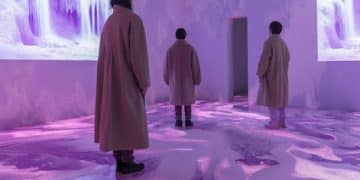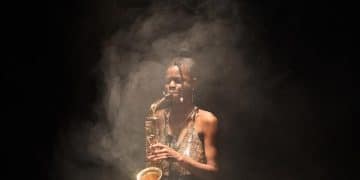Decoding Contemporary Dance: Beginner’s Guide to Movement & Meaning
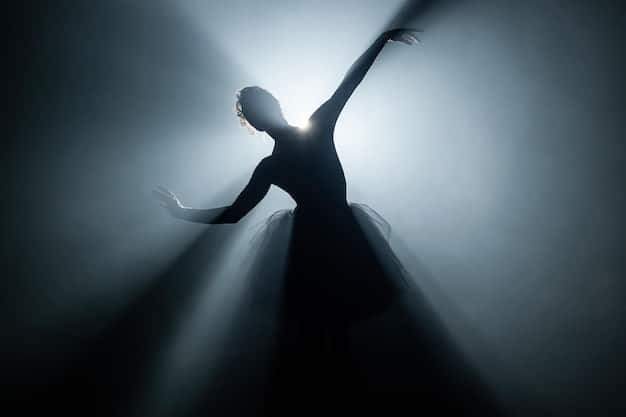
Advertisements
Decoding contemporary dance involves understanding its fluid, rule-breaking nature, an art form that merges diverse styles to express profound human experiences through innovative movement and often abstract narratives, inviting personal interpretation.
Embarking on the journey of understanding an art form as fluid and diverse as contemporary dance can seem daunting at first. However, Decoding Contemporary Dance: A Beginner’s Guide to Understanding Movement and Meaning offers a clear pathway to appreciate this captivating artistic expression. This guide aims to demystify its core principles, enabling you to connect with the raw emotion and intricate storytelling inherent in each performance.
The Evolution of Contemporary Dance: A Brief History
Contemporary dance, an art form that often defies rigid classification, boasts a rich and fascinating history rooted in a spirit of rebellion and innovation. Its origins are deeply intertwined with a rejection of the strictures found in classical ballet and the more formalized aspects of modern dance. Over time, it has evolved into a uniquely expressive genre that embraces fluidity, individuality, and a boundless vocabulary of movement.
The early 20th century saw pioneers like Martha Graham, Merce Cunningham, and Paul Taylor begin to break away from traditional forms, seeking new ways to communicate through the body. They questioned established norms, experimented with gravity, breath, and the nuanced expressions of human emotion, laying the groundwork for what would become contemporary dance. This period was marked by a desire to explore the human condition with greater authenticity and a broader palette of physical expression.
From Modern to Contemporary: Key Distinctions
While often used interchangeably, “modern” and “contemporary” dance possess distinct characteristics that mark their historical progression and artistic philosophies. Understanding these differences is crucial for appreciating the nuances of each form.
- Modern Dance: Rooted in the early to mid-20th century, modern dance often focused on structured techniques developed by individual pioneers, such as Graham’s contraction and release, or Limón’s fall and recovery, aiming to express psychological states and narratives.
- Contemporary Dance: Emerging from the latter half of the 20th century, contemporary dance embraces a more eclectic approach, drawing from ballet, modern, jazz, street dance, and even global dance forms. It emphasizes improvisation, versatility, and often a less linear narrative, promoting a deeply personal and often abstract interpretation.
The transition from modern to contemporary reflects a broader shift in artistic thought, moving from established techniques toward a more fluid and inclusive exploration of movement. This evolution has allowed contemporary dance to remain perpetually fresh and relevant, adapting to new ideas and cultural shifts.
In essence, contemporary dance thrives on its ability to integrate a myriad of influences, creating a mosaic of movement that is both intellectually stimulating and viscerally engaging. It is a testament to the persistent human drive to communicate beyond words, through the intricate language of the body.
Understanding the Core Elements of Contemporary Dance
Contemporary dance, at its heart, is a dialogue between the dancer’s body, space, time, and the underlying emotional landscape. Unlike more rigid forms, it prioritizes a freedom of movement that allows for profound personal expression and innovative storytelling. Deconstructing its core elements helps to better appreciate the artistic choices made by choreographers and dancers.
The physicality in contemporary dance is deeply exploratory. Dancers often utilize gravity not as a limitation, but as a dynamic force, incorporating falls, rolls, and an organic connection to the floor. This grounded approach differs significantly from the anti-gravitational aspirations of classical ballet, showcasing a raw, earthy quality in movement.
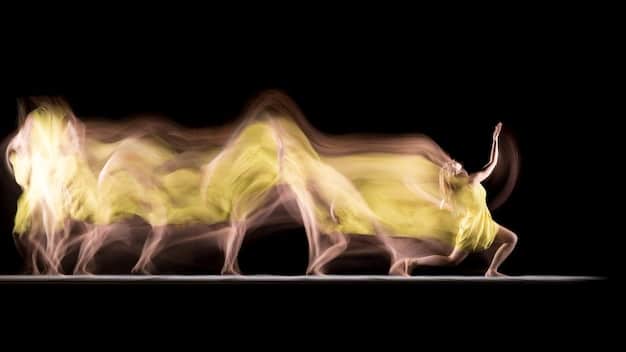
Space, Time, and Dynamics: The Choreographer’s Tools
Choreographers in contemporary dance wield space, time, and dynamics as their primary tools, sculpting movement into intricate visual and emotional narratives. The perception of these elements can profoundly alter the audience’s experience.
- Space: Dancers explore every dimension of the performance area – using levels (high, medium, low), directions (forward, backward, diagonal), and pathways (curved, straight) to create visual interest and thematic emphasis. The interplay with space can convey isolation, freedom, or connection.
- Time: The manipulation of tempo, rhythm, and duration is crucial. Movements can shift from slow, sustained gestures to rapid, percussive bursts, altering the emotional texture and narrative pace. Syncopation and silence can be as impactful as continuous motion.
- Dynamics: This element refers to the quality of movement – how it is performed. Is it sharp or soft, heavy or light, strong or gentle? Dynamics infuse movement with intention and emotional nuance, transforming mere steps into expressive statements.
Beyond these technical aspects, concepts such as improvisation and contact improvisation are integral to contemporary dance. Improvisation allows dancers to create movement spontaneously, fostering a unique connection to the present moment and fostering genuine artistic discovery. Contact improvisation, where dancers explore shared weight, balance, and mutual support, further enhances the collaborative and organic nature of the form.
Ultimately, decoding contemporary dance involves recognizing how these fundamental elements intertwine to create a comprehensive sensory experience. It’s about observing not just “what” the body is doing, but “how” and “why,” inviting viewers into a deeper appreciation of the work’s emotional and intellectual layers.
Themes and Narratives: What Contemporary Dance Communicates
Contemporary dance is a powerful medium for exploring the vast spectrum of human experience, from the deeply personal to the universally political. Unlike narrative ballet, which often relies on established storylines, contemporary works frequently delve into abstract themes, leaving significant room for audience interpretation. This open-ended approach is one of its defining characteristics, inviting viewers to engage intellectually and emotionally with the performance.
The themes explored in contemporary dance are as diverse as the choreographers and dancers themselves. They often reflect societal issues, psychological states, philosophical questions, or simply the beauty and complexity of human relationships. A piece might tackle environmental concerns, mental health struggles, or the nuances of identity, all expressed through the visceral language of the body.
Beyond the Literal: Unpacking Symbolism and Abstraction
A key aspect of appreciating contemporary dance is understanding its frequent reliance on symbolism and abstraction. Choreographers often use movement, costume, lighting, and sound to evoke ideas and emotions rather than explicitly narrate events. This requires a different kind of engagement from the audience, shifting from a search for “what happens next” to an inquiry into “what does this feel like” or “what does this represent?”
- Symbolism in Movement: A specific gesture, a recurring motif, or a spatial relationship between dancers can symbolize broader concepts—love, conflict, hope, despair. For instance, a dancer repeatedly reaching upwards might symbolize aspiration, while a confined space could represent entrapment.
- Abstraction: Many contemporary works embrace pure abstraction, focusing solely on the aesthetics of movement, form, and rhythm without a specific storyline or symbolic representation. Here, the beauty lies in the visual and kinetic patterns, the interplay of bodies in space, and the sheer physicality of the performance.
The beauty of this approach lies in its capacity for multiple interpretations. What one audience member perceives as a commentary on social isolation, another might experience as an expression of personal resilience. This ambiguity is not a flaw, but a deliberate artistic choice, fostering a deeper, more introspective connection with the art form.
Therefore, when approaching contemporary dance, it’s beneficial to set aside expectations of a straightforward plot. Instead, allow yourself to be open to the emergent meaning, the emotional resonance, and the symbolic nuances that unfold through the dancers’ bodies and the overall choreographic landscape.
The Role of Music and Other Production Elements
While movement remains the cornerstone of contemporary dance, the other production elements—music, lighting, costume, and set design—are equally vital in shaping the audience’s experience and conveying the piece’s overall message. These elements are not mere accompaniments; they are integral components that enhance, contextualize, and sometimes even drive the choreography.
The choice of music, in particular, can profoundly influence the interpretation of a dance. Contemporary dance embraces an extraordinarily wide range of musical styles, from classical compositions and jazz to electronic soundscapes, ambient noise, and even silence. The relationship between sound and movement can be symbiotic, contrapuntal, or even completely independent, each choice creating a distinct atmospheric and emotional tone.
Beyond the Stage: Lighting, Costume, and Set Design
These elements work in concert to build the world of the dance, guiding the audience’s focus and deepening their understanding of the narrative or thematic content.
- Lighting: More than just illuminating the stage, lighting can sculpt space, create mood, highlight specific dancers or sections, and even suggest time of day or emotional states. A single spotlight can convey isolation, while a wash of warm light might evoke comfort.
- Costume: Costumes in contemporary dance range from everyday wear to highly abstract or sculptural garments. They inform character, suggest a period or setting, and can either restrict or enhance movement. Sometimes, the body itself, in minimal attire, becomes the primary visual element.
- Set Design: Sets can be elaborate, minimalist, or non-existent. They can create a literal environment, provide abstract structures for interaction, or simply define the performance space. Even an empty stage, by its very blankness, makes a statement.
Conversely, some contemporary works push the boundaries by removing or minimizing these traditional elements, focusing solely on the raw power of the human body in space. This minimalist approach can be equally compelling, stripping away distractions to reveal the essence of movement and expression. Understanding how these production elements are utilized, or deliberately omitted, provides another layer of appreciation for the choreographer’s vision and the performance’s overall impact.
Engaging with a Contemporary Dance Performance: Tips for Beginners
Attending a contemporary dance performance can be an incredibly rewarding experience, but for newcomers, it can sometimes feel enigmatic. The key to unlocking its beauty and meaning lies in approaching it with an open mind and a willingness to engage on a non-literal level. Instead of searching for a definitive plot, focus on the sensory and emotional journey the performance offers.
One of the most important tips is to let go of preconceived notions of what dance “should” be. Contemporary dance often challenges traditional aesthetics and narratives, inviting a more introspective and subjective response. Allow yourself to react intuitively to the movement, the music, and the overall atmosphere created on stage.
From Observation to Interpretation: Finding Your Connection
Connecting with contemporary dance is a personal journey, and there’s no single “right” way to interpret a piece. However, several strategies can enhance your viewing experience and deepen your appreciation.
- Observe Movement Qualities: Pay attention to how the dancers move. Is it fluid or staccato? Heavy or light? Fast or slow? These qualities often convey emotional states or thematic ideas.
- Consider Relationships: Notice how dancers interact with each other and with the space. Are they connected, isolated, in conflict, or in harmony? Their spatial relationships can communicate complex dynamics.
- Reflect on Personal Resonance: Allow the performance to evoke your own emotions, memories, or thoughts. Contemporary dance often speaks to universal human experiences, and your personal connection to these themes can be profound.
- Read Program Notes: If available, program notes can offer valuable insights into the choreographer’s intent, the themes explored, or the inspiration behind the work, providing a lens through which to view the performance.
Remember that contemporary dance often invites diverse interpretations. Discussing the performance with others afterwards can be incredibly enriching, as it often reveals how different individuals connect with the same work in unique ways. The goal isn’t to “solve” the dance, but to experience it and allow it to resonate with you on a personal level, fostering a deeper connection to this dynamic art form.
The Impact and Future of Contemporary Dance
Contemporary dance is not merely an art form; it is a vital cultural force that continually evolves, reflecting and shaping societal dialogues. Its impact extends far beyond the stage, influencing other artistic disciplines, fostering critical thinking, and offering a unique lens through which to understand the human condition. As a dynamic and responsive art form, its future promises continued innovation and relevance.
This genre’s ability to seamlessly integrate various styles—from traditional forms to digital technologies—ensures its longevity and appeal. It serves as a laboratory for movement, where boundaries are constantly pushed, and a space where personal and collective narratives can be presented in exciting and often challenging ways.
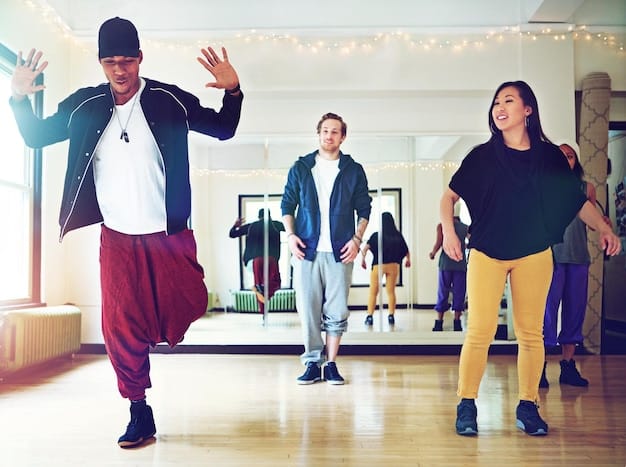
Contemporary Dance in the Digital Age and Beyond
The advent of digital technology has profoundly impacted contemporary dance, opening up new avenues for creation, dissemination, and audience engagement. This integration is set to define much of its future trajectory.
- Digital Performance and Collaboration: Technology enables remote collaborations, virtual performances, and the creation of immersive digital environments that interact with live dancers, blurring the lines between physical and virtual realities.
- Documentation and Accessibility: Online platforms and high-quality video recordings have made contemporary dance more accessible to a global audience, fostering a wider appreciation and understanding of the art form, breaking down geographical barriers.
- Social Commentary: Contemporary dance continues to be a potent tool for social and political commentary, addressing pressing issues of our time with urgency and nuance. Its abstract nature often allows for a more profound and less didactic exploration of complex subjects.
Looking ahead, contemporary dance will likely continue its trajectory of interdisciplinarity, collaborating more frequently with visual artists, musicians, scientists, and technologists. This cross-pollination will ensure its continued freshness and its capacity to speak to an ever-changing world. It remains a vibrant testament to human creativity and the enduring power of movement as a language, constantly reinventing itself while retaining its core commitment to authentic expression.
The future of contemporary dance is not just about new movements, but new ways of thinking about the body, performance, and communication in an increasingly interconnected world.
Notable Pioneers and Influential Works in Contemporary Dance
The landscape of contemporary dance has been shaped by visionary artists whose innovations transcended traditional boundaries and paved the way for its diverse expressions. These pioneers, through their unique techniques and conceptual frameworks, laid the groundwork for an art form committed to exploration and constant reinvention. Understanding their contributions is crucial to grasping the foundational principles and ongoing evolution of contemporary dance.
Each influential choreographer brought a distinctive philosophy to movement, impacting generations of dancers and creators. Their works often reflected the social and cultural shifts of their times, making contemporary dance a living archive of human experience.
Choreographers Who Defined the Genre
While thousands have contributed, certain figures stand out for their profound and lasting influence on the development of contemporary dance. Their approaches highlight the breadth and depth of the art form.
- Merce Cunningham (1919-2009): A seminal figure, Cunningham pioneered dance where chance procedures determined choreography, often divorcing movement from music to allow each element independent life. His work emphasized pure movement and explored spatial and temporal possibilities in revolutionary ways. Key works include “Points in Space” and “Summerspace.”
- Alvin Ailey (1931-1989): Ailey’s work was deeply rooted in the African American experience, blending modern dance, jazz, and African traditions to create accessible and emotionally resonant performances. His company brought contemporary dance to wide audiences, and his masterpiece “Revelations” remains one of the most performed modern dance pieces globally.
- Pina Bausch (1940-2009): A German choreographer developed “Tanztheater” (dance theater), integrating speech, song, and dramatic action with movement to explore complex human relationships and societal issues. Her work was often raw, repetitive, and deeply impactful. Notable pieces include “Rite of Spring” and “Café Müller.”
- William Forsythe (b. 1955): Known for his deconstruction of classical ballet, Forsythe’s work is characterized by extreme athleticism, complex spatial patterns, and intellectual rigor. He redefined balletic vocabulary, pushing bodies to their physical and conceptual limits. “In the Middle, Somewhat Elevated” is a representative work.
These artists, among many others, demonstrate the incredible range within contemporary dance—from pure movement exploration to profound dramatic narratives. Their legacy lies not just in their specific techniques or pieces, but in their courage to question, innovate, and continuously redefine what dance can be. Studying their influence provides a richer context for “decoding contemporary dance,” revealing the layers of history and artistic intent behind each new creation.
| Key Aspect | Brief Description |
|---|---|
| ✨ Evolution | Emerges from modern dance, rejecting strict forms, embracing fluidity and individuality. |
| 🤸 Core Elements | Focuses on body, space, time, and dynamics, often using improvisation and grounded movement. |
| 🎭 Themes | Explores human experience, symbolism, and abstraction, inviting audience interpretation. |
| 🚀 Future | Interdisciplinary, integrates digital tech, and continues as a powerful social commentary. |
Frequently Asked Questions about Contemporary Dance
▼
Contemporary dance emphasizes fluidity, improvisation, and a grounded connection to the floor, often breaking traditional forms. Ballet, conversely, adheres to strict forms, classical techniques, and aims for an ethereal, anti-gravitational aesthetic.
▼
Absolutely not. Contemporary dance is designed to be accessible to all, inviting personal interpretation. An open mind and a willingness to simply experience the movement and emotion are far more valuable than technical knowledge.
▼
Not necessarily. While some pieces may have a clear narrative, many contemporary works delve into abstract themes, emotions, or concepts, focusing on the quality of movement itself. This allows for diverse audience interpretations.
▼
Music’s role is highly varied. It can be traditional, electronic, ambient, or entirely absent. Sometimes, music drives the movement; other times, it provides a contrasting layer, or the dance exists independently of a musical score.
▼
Attend diverse performances, read program notes, watch documentaries, and explore online resources showcasing various choreographers and companies. Engaging in post-performance discussions can also deepen your understanding and appreciation.
Conclusion
Decoding Contemporary Dance: A Beginner’s Guide to Understanding Movement and Meaning should demystify this captivating art form, transforming what might seem obscure into an accessible and deeply enriching experience. Contemporary dance, with its fluid boundaries and profound expressive capacity, invites us to look beyond literal narratives and embrace the vast spectrum of human emotion conveyed through the language of the body. Its ongoing evolution ensures its relevance, capturing the pulse of our times and offering a unique lens through which to explore complex ideas and feelings. By approaching contemporary dance with an open mind and a willingness to feel rather than just see, a world of intricate beauty and resonant meaning unfolds, proving that true understanding often comes from intuitive engagement.
